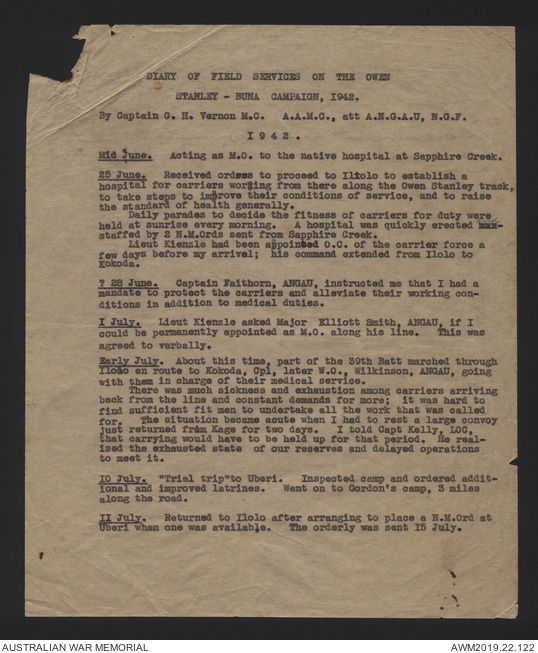| Service number | P390 |
|---|---|
| Ranks Held | Captain, Major |
| Birth Place | United Kingdom: England, Sussex |
| Death Date | 16/05/1946 |
| Death Place | New Guinea: Papua New Guinea, Papua |
| Final Rank | Captain |
| Service | Australian Army |
| Units |
|
| Places | |
| Conflicts/Operations |
|
Captain Geoffrey Hampden Vernon
Geoffrey Hampden Vernon was born on 16 December 1882 at Hastings, England, to architect Walter Liberty Vernon and his wife Margaret Anne (née Jones). He had two sisters and one brother and in 1883, the family moved to Sydney, a measure taken to improve his father’s health. Geoffrey was educated at Sydney Church of England Grammar School and the University of Sydney, obtaining a Bachelor of Medicine in 1905, and a Master of Surgery in 1907. He became a medical practitioner, and practiced in country towns in New South Wales and Queensland. By 1914, Geoffrey was living in Winton, Queensland, and had become Medical Superintendent of the Winton hospital.
Geoffrey Hampden Vernon was appointed as a captain and posted to the 4th Light Horse Field Ambulance on 4 March 1915. He embarked on 2 June 1915 on board HMAT Medic and was attached to the 11th Light Horse Regiment as a medical officer. It is probable that he served in Gallipoli with this unit before being evacuated to Egypt in January 1916 and serving in the Middle East. On 13 October 1916, Vernon was awarded a Military Cross and mentioned in despatches for “conspicuous gallantry and devotion to duty. He tended the wounded under heavy fire, displaying great courage and determination. Later he remained out all night with a wounded man”. Vernon was promoted to major on 29 January 1917.He spent much of 1917 in and out of hospital with illness, and was He was wounded in action on 7 November 1917. By July 1918, Vernon was transferred to the Assistant Director of Medial Services in Cairo. He returned to Australia on 17 July 1918 per HT Port Darwin, arriving on 17 August 1918. Upon Vernon’s return he was discharged from the Australian Imperial Forces, but was added to the Reserve of Officers as a major for both New South Wales and Queensland.
After the war, Vernon spent some time practicing medicine in the Cobar region of New South Wales. In September 1921, he was appointed government medical officer on Thursday Island, and visiting surgeon to the Thursday Island Prison. He continued to practice medicine on Thursday Island until 1932, when he moved to Daru, New Guinea. There, he bought a store and a small kapok plantation and continued to work as a doctor. Vernon sold his property on Daru in 1938, and bought a coconut plantation at Port Glasgow in eastern Papua. There, he attempted to grow kapok and rubber. He was then appointed government medical officer on Misima Island.
Geoffrey Hampden Vernon enlisted to serve in the Second World War on 27 February 1942. He was a captain in the Australian Army Medical Corp and attached to HQ 1 Papuan Infantry Battalion as a medical officer. With this unit, he served on the Kokoda Trail and attended to the sick and wounded. Known as “Doc Vernon” or “the old Doc”, he was held in high regard by both Australians and Papuans. Vernon was posted as resident medical officer to the Australian New Guinea Administrative Unit on 1 June 1943, and was awarded a mention in despatches on 23 December 1943. On 3 March 1946, Vernon ceased full time duty and retired to his plantation at Port Glasgow.
Vernon became ill, and died on 16 May 1946 at Samarai, New Guinea.
